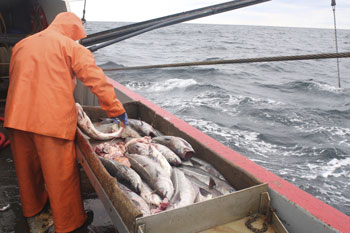New Mechanism to Preserve
Groundfish Access
by Laurie Schreiber

“The guys fishing face pretty tough cuts in quota next year. And young guys need affordable access to get into the fishery for the future,” said Patrick Shepard. The PERC website connects potential new entrants to the fishery. These little- or no-quota permits may provide the best opportunity for access into the fishery by part-time or small-scale fishermen. © Photo by Sam Murfitt
STONINGTON – The Penobscot East Resource Center’s New Entrants Program seeks to find pathways for successful entry into the groundfishery by small-scale, community based fishermen.
“We understand that there’s a need for more affordable access for the fishery,” said PERC fisheries policy associate Patrick Shepard.
The program can be viewed through the new website fisheriesaccessnetwork.org. “The website is for both fishermen who hold permits and might be thinking about selling, and for those who are seeking access into the fishery, and there are separate applications for each,” says PERC. “Fishermen can apply online, or download and print the application and mail it to Penobscot East. “
“We’re not blind to the problems going on in the industry right now,” said Shepard. “The guys fishing face pretty tough cuts in quota next year. And young guys need affordable access to get into the fishery for the future.”
The website connects potential new entrants to the fishery, who wish to buy quota, with existing fishermen who want to sell permits that they hold that have little or no quota.
Between 2009-2012, 79 northeast multispecies permits were terminated due to non-renewal or voluntarily surrendered. “Once a limited access permit is forfeited, it can never be reinstated. It’s gone forever,” said PERC. “This means that the total allowable catch for the fishery is condensed into fewer and fewer hands. If this trend continues, a small handful of businesses will own the vast majority of the fishing rights for multispecies.
These little- or no-quota permits may provide the best opportunity for access into the fishery by part-time or small-scale fishermen. The permits are less expensive to acquire and fishermen have the opportunity to lease quota from permit banks or the open market. The Fisheries Access Network will help facilitate the transfer of these permits to new fishermen.”
The website was launched in late summer.
Do young fishermen want to get into groundfishing, given the challenges?
“That’s an interesting question,” said Shepard. “We work with fishermen from Eastport, Cape Cod and Point Judith. We’ve got more interest in the Cape Cod area because the fish are there. In eastern Maine, it’s tough to get guys interested in a fishery that is brand-new to them. A lot of younger guys haven’t experienced groundfish before because the stocks aren’t strong. And also, in eastern Maine, the lobster fishery is booming. They don’t have any need to get into another fishery. But they should understand that the lobster thing might not last forever. And if they have access to another fishery, it could be beneficial for their future.”
How it works: Potential new entrants to the groundfishery go to the website and click on the “buyers” tab. There, they can either fill out an online application or download the application and mail it in. PERC and Coastal Enterprises, Inc., collaborate with applicants to write out a business plan and work through the financial planning process. If all goes well, the program connects the potential buyers with potential sellers.
The program is funded by the National Fish and Wildlife Foundation and is free.
So far, seven sellers have signed up with the network. The value of their permits cannot be quantified because it depends on how much quota is attached to the permit – sometimes it’s zero, on how much the seller wants, and on how much the buyer is willing to pay, said Shepard.
On the buyer side, there are four active participants, and four more applications under review, he said. The key is affordability, he said.
“We’re also looking into other avenues for access down the road,” he said. “If fish stocks come back and come back in any sort of major, commercial way, the number of permits that would be available for new-entrant fishermen would be a drop in bucket compared to actual need.”
